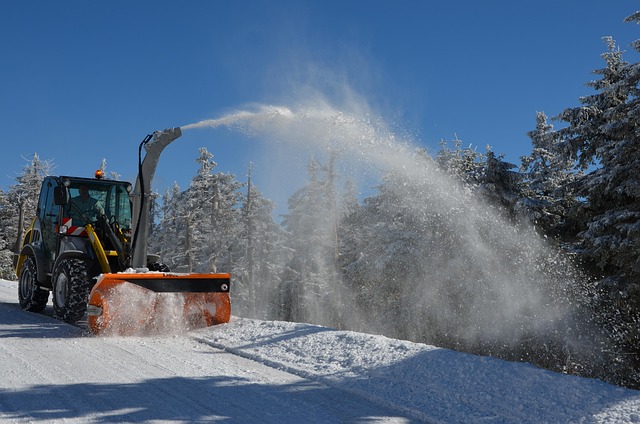After a storm, damaged trees and branches pose significant risks to Anderson, SC, commercial properties. Understanding the extent of storm damage is crucial before attempting any removal. Professional storm debris removal becomes essential for safety and property protection. This comprehensive guide details the steps from assessment to final cleanup, emphasizing safety measures. Learn why prompt action and expert care are vital for restoring your commercial space after a storm, ensuring a smooth and secure return to operations in Anderson, SC.
- Understanding Storm-Damaged Trees and Branches
- Why Professional Removal is Essential for Commercial Properties in Anderson, SC
- The Step-by-Step Process of Storm Debris Removal
- Safety Considerations and Post-Removal Care for Your Property
Understanding Storm-Damaged Trees and Branches
After a severe storm, many property owners in Anderson, SC, are left assessing the damage to their trees and landscapes. Understanding the extent of storm-damaged trees and branches is crucial for safe and effective removal. These storms often leave behind a significant amount of debris, including broken limbs, uprooted trees, and fallen branches—a task that requires professional assistance for commercial properties.
Commercial property managers should remember that storm-damaged trees can pose serious safety hazards if not handled promptly. The weight of heavy branches or entire tree falls can cause substantial damage to buildings, power lines, and other structures on the property. Retaining a qualified arborist or storm debris removal service in Anderson is essential to assess and safely remove these hazardous elements, ensuring the protection of both the property and its occupants.
Why Professional Removal is Essential for Commercial Properties in Anderson, SC
After a storm, proper tree and branch removal is crucial for maintaining the safety and aesthetics of commercial properties in Anderson, SC. While some minor cleanup may be manageable, professional removal services are essential for several reasons. First, they possess the specialized equipment and trained personnel needed to handle large debris, reducing the risk of injury or further property damage. These professionals also understand local regulations regarding tree removal, ensuring compliance and minimizing potential legal issues.
Moreover, storm debris removal on commercial properties requires efficient planning and execution. Professionals can quickly assess the damage, prioritize hazardous materials, and develop a safe, effective cleanup strategy tailored to the unique needs of each site. This expertise is vital for businesses aiming to minimize downtime and return to operations swiftly following a storm event.
The Step-by-Step Process of Storm Debris Removal
After a severe storm, commercial property owners in Anderson, SC, often face the daunting task of clearing storm debris, including fallen trees and branches. The process requires careful planning and expertise to ensure safety and minimize damage. Here’s a step-by-step guide for effective storm debris removal:
1. Assess the Damage: Begin by conducting a thorough inspection of your property. Identify all fallen trees, branches, and other debris, assessing their size, location, and potential hazards. Prioritize areas with blocked entrances or structures at risk of further damage.
2. Clear Immediate Hazards: For safety reasons, address any immediate threats first. Remove or secure large, heavy branches hanging over buildings or power lines to prevent potential injury or property damage. Use appropriate tools like chainsaws for tree and branch removal, ensuring a clear work area and following all safety guidelines.
3. Remove Smaller Debris: Once the immediate hazards are under control, turn your attention to smaller debris like twigs, leaves, and broken branches. Collect them into piles and use garbage bags or specialized debris collection containers to facilitate efficient disposal or recycling.
4. Dispose or Recycle Responsibly: Properly dispose of debris according to local regulations. Some areas offer specific collection days for storm-related waste, while others may require private haulers. Alternatively, consider recycling or composting organic materials, such as leaves and grass clippings, to benefit the environment.
5. Retain Essential Resources: As you remove debris, be mindful of salvaging useful materials. Wood from healthy trees can often be repurposed or sold for lumber. Smaller branches may be chipped for mulch, providing a valuable resource for landscaping.
Safety Considerations and Post-Removal Care for Your Property
When dealing with storm-damaged trees and branch removal, especially on commercial properties in Anderson, SC, safety should always be the top priority. Before beginning any cleanup, assess the area for potential hazards such as power lines or other obstructions that could cause injury. Wear appropriate protective gear, including gloves, hard hats, and eye protection, to minimize risks associated with fallen trees and sharp debris. It’s crucial to have a clear plan and proper equipment for storm debris removal to ensure everyone’s safety on the property.
After successful tree and branch removal, proper post-care is essential to maintain your Anderson SC commercial property. Remove all debris from the site, ensuring it’s properly disposed of or recycled according to local regulations. Inspect the remaining landscape for any structural damage and address these issues promptly. Regular maintenance and care after storm events help prevent future damage and ensure your property remains a safe and welcoming space for employees, customers, and visitors.
